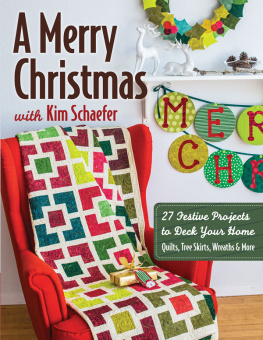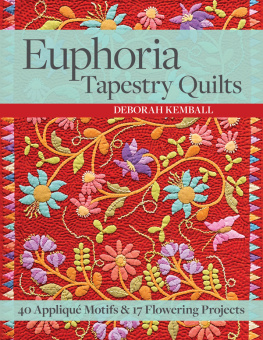Publisher: Amy Marson Creative Director: Gailen Runge Editor: Lynn Koolish Technical Editors: Helen Frost and Linda Johnson Cover Designer: Christina Jarumay Fox Book Designers: Kristen Yenche and Kerry Graham Production Coordinator: Tim Manibusan Production Editor: Alice Mace Nakanishi Illustrator: Mary E. Flynn Photo Assistants: Carly Jean Marin and Mai Yong Vang Instructional photography by Diane Pedersen of C&T Publishing, unless otherwise noted Published by C&T Publishing, Inc., P.O. Box 1456, Lafayette, CA 94549 acknowledgments Thank you to everyone at C&T Publishing. Special thanks to: Helen Frost, my technical editor. Helen and I have worked on nearly all of my books, and I have come to consider her not only a friend but the best technical editor ever. Diane Minkley of Patched Works, Inc.
Diane has been the longarm quilter on most of my books. I truly appreciate all you do. My daughter, Ali May. You rock at name that quilt. My husband, Gary. He has typed all my books and over the years has become a very good pre-editor in his own right.
Thanks, hon.  introduction I love to celebrate the changing seasons, and fall has always been a favorite. This book contains a collection of pieced and appliqud projects for fall that are perfect for decorating your home or for gift giving. There are projects to carry you from Halloween all through the fall season. Whether you are a first-time sewist or an experienced quilter, there are projects in this book that are appropriate for your skill level. The designs use machine appliqu and simple piecing techniques.
introduction I love to celebrate the changing seasons, and fall has always been a favorite. This book contains a collection of pieced and appliqud projects for fall that are perfect for decorating your home or for gift giving. There are projects to carry you from Halloween all through the fall season. Whether you are a first-time sewist or an experienced quilter, there are projects in this book that are appropriate for your skill level. The designs use machine appliqu and simple piecing techniques.
There are lap quilts, wall quilts, table toppers, runners, place mats, and towels. I hope this collection of projects will inspire you to create and to celebrate the season. 
 rotary cutting I recommend that you cut all the fabrics used in the pieced blocks, borders, and bindings with a rotary cutter, an acrylic ruler, and a cutting mat. Trim the blocks and borders with these tools as well. piecing All piecing measurements include seam allowances. pressing For cotton fabrics, press seams to one side, preferably toward the darker fabric. pressing For cotton fabrics, press seams to one side, preferably toward the darker fabric.
rotary cutting I recommend that you cut all the fabrics used in the pieced blocks, borders, and bindings with a rotary cutter, an acrylic ruler, and a cutting mat. Trim the blocks and borders with these tools as well. piecing All piecing measurements include seam allowances. pressing For cotton fabrics, press seams to one side, preferably toward the darker fabric. pressing For cotton fabrics, press seams to one side, preferably toward the darker fabric.
Press flat, and avoid sliding the iron over the pieces, which can distort and stretch them. When you join two seamed sections, press the seams in opposite directions so you can nest the seams and reduce bulk. appliqu All appliqu instructions are for paper-backed fusible web with machine appliqu, and all the patterns have been drawn in reverse. If you prefer a different appliqu method, you will need to trace a mirror image of the pattern and add seam allowances to the appliqu pieces. A lightweight paper-backed fusible web works best for machine appliqu. General Appliqu Instructions Trace all parts of the appliqu design on the paper side of the fusible web. General Appliqu Instructions Trace all parts of the appliqu design on the paper side of the fusible web.
Trace each layer of the design separately. Whenever two shapes in the design butt together, overlap them by about to help prevent any potential gap between them. Note: The pumpkins in Autumn Splendor and Pumpkin Patch were done as layered shapes instead of individual pieces. When tracing the shapes, extend the underlapped edge beyond the drawn edge in the pattern. Write the pattern piece number on each traced shape. Note: Some of the patterns are larger than the width of the fusible web and will need to be traced in sections rather than as a single piece.
Cut around the appliqu shapes, leaving a margin around each piece. Iron each fusible web shape to the wrong side of the appropriate fabric, following the manufacturers instructions for fusing. I dont worry about the grainline when placing the pieces. Cut on the traced lines and peel off the paper backing. A thin layer of fusible web will remain on the wrong side of the fabric. This layer will adhere the appliqu pieces to the backgrounds.
Position the pieces on the backgrounds. Press to fuse them in place. Machine stitch around the appliqu pieces, using a zigzag, satin, or blanket stitch. Stitch any detail lines indicated on the patterns. My choice is the satin stitch. I generally use matching threads for all the stitching.
As always, the type of stitching you use and the thread color you select are personal choices. putting it all together When all the pieces for a project are completed, arrange them on the floor or, if you are lucky enough to have one, a design wall. Arrange and rearrange the pieces until you are happy with the overall look. Each project has specific directions as well as diagrams and photos for assembly. layering the quilt Cut the batting and backing pieces 45 larger than the quilt top. Place the pressed backing on the bottom, right side down.
Place the batting over the backing and then position the quilt top on top, right side up. Make sure that all the layers are flat and smooth and that the quilt top is centered over the batting and backing. Pin or baste the quilt. note If you are going to have your top quilted by a longarm quilter, contact the quilter for specific batting and backing requirements, as they may differ from the instructions above. quilting Quilting is a personal choiceyou may prefer hand or machine quilting. My favorite method is to send the quilt top to a longarm quilter.
This method keeps the number of my unfinished tops low and the number of my finished quilts high. yardage and fabric requirements I have given yardage and fabric requirements for each project. Many projects call for a total amount of assorted fabrics that can be used as a base for your project. The yardage amounts may vary, depending on the number of fabrics used and the number of pieces you cut from each fabric. Always cut the pieces for the patchwork first and then cut any appliqu pieces. Fabric amounts are based on a usable width of 42.
Fusible web amounts are based on a width of 17. The amounts given for binding allow for 2-wide strips cut on the straight grain. I usually use the same fabric for backing and binding; its a good way to use leftover fabric. Cut the binding strips on either the crosswise or lengthwise grain of the leftover fabric, whichever will yield the longest strips. I used bias binding for the oval place mats.  spice This lap quilt is perfect to cuddle up under on a chilly fall night.
spice This lap quilt is perfect to cuddle up under on a chilly fall night.  spice This lap quilt is perfect to cuddle up under on a chilly fall night.
spice This lap quilt is perfect to cuddle up under on a chilly fall night.
Make it for Halloween in orange and black, or choose your favorite fall colors.  Quilted by Diane Minkley of Patched Works, Inc. finished quilt: 50 70 | finished block: 10 10 materials Assorted oranges: 2 yards total for pieced blocks Black: 1 yard for pieced blocks Assorted black-and-white prints: 1 yards total for blocks Batting: 55 75 Backing and binding: 3 yards (pieced crosswise) cutting Cut from assorted oranges:
Quilted by Diane Minkley of Patched Works, Inc. finished quilt: 50 70 | finished block: 10 10 materials Assorted oranges: 2 yards total for pieced blocks Black: 1 yard for pieced blocks Assorted black-and-white prints: 1 yards total for blocks Batting: 55 75 Backing and binding: 3 yards (pieced crosswise) cutting Cut from assorted oranges: 
Next page












 introduction I love to celebrate the changing seasons, and fall has always been a favorite. This book contains a collection of pieced and appliqud projects for fall that are perfect for decorating your home or for gift giving. There are projects to carry you from Halloween all through the fall season. Whether you are a first-time sewist or an experienced quilter, there are projects in this book that are appropriate for your skill level. The designs use machine appliqu and simple piecing techniques.
introduction I love to celebrate the changing seasons, and fall has always been a favorite. This book contains a collection of pieced and appliqud projects for fall that are perfect for decorating your home or for gift giving. There are projects to carry you from Halloween all through the fall season. Whether you are a first-time sewist or an experienced quilter, there are projects in this book that are appropriate for your skill level. The designs use machine appliqu and simple piecing techniques.
 rotary cutting I recommend that you cut all the fabrics used in the pieced blocks, borders, and bindings with a rotary cutter, an acrylic ruler, and a cutting mat. Trim the blocks and borders with these tools as well. piecing All piecing measurements include seam allowances. pressing For cotton fabrics, press seams to one side, preferably toward the darker fabric. pressing For cotton fabrics, press seams to one side, preferably toward the darker fabric.
rotary cutting I recommend that you cut all the fabrics used in the pieced blocks, borders, and bindings with a rotary cutter, an acrylic ruler, and a cutting mat. Trim the blocks and borders with these tools as well. piecing All piecing measurements include seam allowances. pressing For cotton fabrics, press seams to one side, preferably toward the darker fabric. pressing For cotton fabrics, press seams to one side, preferably toward the darker fabric. spice This lap quilt is perfect to cuddle up under on a chilly fall night.
spice This lap quilt is perfect to cuddle up under on a chilly fall night.  Quilted by Diane Minkley of Patched Works, Inc. finished quilt: 50 70 | finished block: 10 10 materials Assorted oranges: 2 yards total for pieced blocks Black: 1 yard for pieced blocks Assorted black-and-white prints: 1 yards total for blocks Batting: 55 75 Backing and binding: 3 yards (pieced crosswise) cutting Cut from assorted oranges:
Quilted by Diane Minkley of Patched Works, Inc. finished quilt: 50 70 | finished block: 10 10 materials Assorted oranges: 2 yards total for pieced blocks Black: 1 yard for pieced blocks Assorted black-and-white prints: 1 yards total for blocks Batting: 55 75 Backing and binding: 3 yards (pieced crosswise) cutting Cut from assorted oranges: 